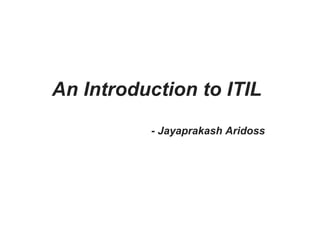
Itil V3
- 1. An Introduction to ITIL - Jayaprakash Aridoss
- 5. Back
Notes de l'éditeur
- Service: A service is a means of delivering value to customers by facilitating outcomes customers want to achieve without the ownership of specific costs and risks. Service Management: Service Management is a set of specialized organizational capabilities for providing value to customers in the form of services.
- SLA - A written agreement between an IT Service provider and the IT Customer(s), defining the key service targets and responsibilities of both parties. SLM – Underpinning contract A contract with an external supplier covering delivery of services that support the IT organization in their delivery of services. Operational Level Agreement (OLA) An internal agreement covering the delivery of services which support the IT organization in their delivery of services.
- Highlighted topics are key principle
- Event :An event is a change of state that has significance for the management of a configuration item or IT service. Incident: An incident is an unplanned interruption to an IT service, or a reduction in the quality of an IT service. Failure of a configuration item that has not yet impacted service is also an incident. Service Request: A service request is a request from a user for information or advice, or for a standard change, or for access to an IT service. Problem: A problem is a cause of one or more incidents. The cause is not usually known at the time a problem record is created, and the problem management process is responsible for further investigation. T Operations Control is usually staffed by shifts of operators who carry out routine operational tasks. They provide centralized monitoring and control, usually from an operations bridge or network operations centre. Facilities Management is responsible for management of data centres, computer rooms and recovery sites. Facilities Management also coordinates large-scale projects, such as data centre consolidation or server consolidation.
- Technology metrics:often associated with component and application based metrics such as performance, availability. Process metrics:captured in the form of Critical Success Factors (CSFs), Key Performance Indicators (KPIs) and activity metrics. Service metrics:the results of the end-to-end service. Component/technology metrics are used to compute the service metrics.